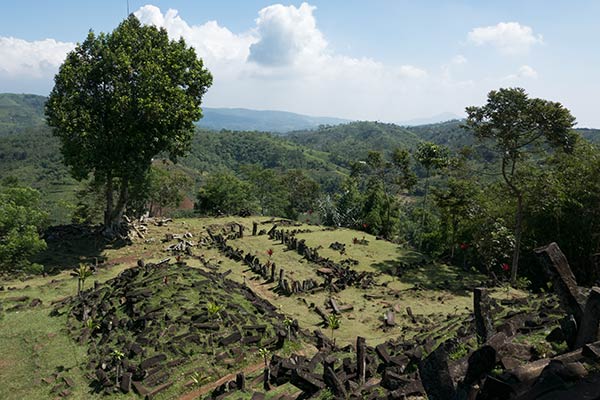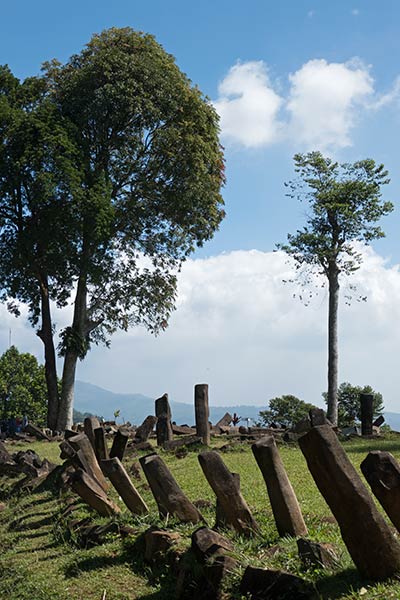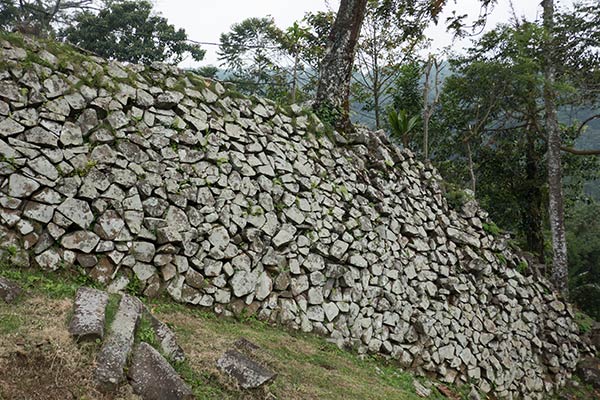
Gunung Padang, Java, Indonesia (बढ़ाना)
The following essay was prepared by एंड्रयू कॉलिन्स, a leading scholar of ancient civilizations.
Gunung Padang, in Indonesia's West Java province, is seen as Southeast Asia's largest and most enigmatic megalithic complex. Located near the village of Karyamukti, some 20 miles (30 kilometers) from the city of Cianjur, and 55 miles (90 kilometers) from the capital Jakarta, it consists of a series of rectangular stone enclosures with inner partitions, walkways and gate entrances, as well as various rock mounds, all of them in a ruinous state. They are constructed of naturally forming andesite, i.e. basaltic, pillars or columnar blocks (like those used in the construction of the ancient city of Nan Madol in Micronesia). The size of the blocks varies between 25 centimeters and 40 centimeters in width and height, and on average around 1.5 meters in length, with a weight of approximately 250 kilograms. Some of blocks are actually much larger in size, with weights exceeding 600 kilograms.
The various structures occupy five separate terraces, or courtyards, each linked by ascending staircases marked with standing pillars. These terraces rise in steps to a height of around 960 meters above sea level, and cover an area of approximately 900 square meters. These courtyards are accessed from the north-northwest via an ascending staircase of 370 steps, which rises at an almost 45º angle. This starts in the valley below, and from its base to the highest terrace it is about 90 meters. Each terrace is positioned one in front of the other on a north-northwest-facing hill formation that is volcanic in nature. Indeed, many geologists believe this is the source of the andesite pillars used to create the stone settings, a fact disputed in the light of recent discoveries.
RADIOCARBON DATES
The site was first mentioned in 1914, when it appeared in Rapporten van de Oudheidkundige Dienst (ROD, "Report of the Department of Antiquities"). It is mentioned again in 1949, within the work of Dutch historian N. J. Krom, although it was not until 1979 that members of the National Archaeology Research Center made a careful examination of its history, archaeology, and geology.
Conventionally, archaeologists and historians place the construction of Gunung Padang's megalithic structures within the Bronze Age, ca. 2500-1500 BC. However, geological surveys conducted at the site since 2011 by Indonesian geologist Danny Hilman Natawidjaja (who earned his doctorate at Cal Tech) of the Indonesian Center for Geotechnical Research suggest the monument is much older – much older indeed.
Core drilling samples and other exploratory excavations have uncovered evidence that Gunung Padang is a multi-leveled structure, one phase being built on top of the next, with evidence of activity on the hill at 22,000-20,000 BC, 14,700 BC, 9,600 BC, 4700 BC and 2800 BC, the final date being the age of the megalithic structures visible today. Indeed, Danny Hilman and his team now believe that the entire hill is an artificial pyramid of incredible antiquity. If correct, this would make it the oldest built structure anywhere in the world. The ranges of dates cited above derive from carbon-14 testing of organic materials taken from core drilling samples extracted from a series of different depths. If the radiocarbon dates can be shown to relate to human activity, and are not simply the result of natural sediment accumulation on the hill slopes, it is feasible that they are the result of Paleolithic peoples occupying or visiting a natural cave site located at the heart of the structure. Indeed, it might well be possible that the megalithic complex was built to surround an existing cave sanctuary of immense antiquity.
Danny agrees with this theory. 3D geo-electric, geo-magnetic and geo-radar surveys have revealed the presence of a hollow chamber 10 meters in width, height and length at a depth beneath the hill of approximately 25 meters. It apparently even has two doors in its hallway. He adds that the existence of this suspected cave chamber was the most likely impetus behind the construction of the multi-layered pyramid structure as early as the Upper Paleolithic age. This is supported by the organic samples extracted from this great depth, which have produced radiocarbon dates in the range of 22,000-20,000 BC.
Further evidence of the artificial construction of the hill comes from the fact that Danny Hilman and his team have uncovered series of andesite pillars laid down in rows beneath the surface of the hill, and since andesitic pillars are only ever created vertically, never horizontally, it means they must form part of an artificial construction (often these andesitic, i.e. basaltic, columnar pillars are six-sided in profile due to the rapid cooling process involved in their manufacture.

Gunung Padang, Java, Indonesia (बढ़ाना)
THE MATTER OF ORIENTATION
One matter I did attempt to examine with the help of chartered engineer Rodney Hale were the possible motivations behind Gudung Padang's north-northwesterly orientation. I felt that if this could be established with some certainty it might provide a better understanding not only of the beliefs and practices of its megalithic builders, but also of its date of construction.
The first thing we had to consider was the nature of the multiple stone settings, which are situated on five separate terraces or levels. Were these definitely orientated north-northwest, or might they in fact face toward the south-southeast? Rodney quickly determined that it could not be the latter, since the landscape rises considerably toward the south-southeast making it a very unlikely direction of orientation. In contrast the view to the north-northwest is unhindered, but for a single hill or mountain some 6 miles (10 kilometers) away. This rises to a height of approximately 1040 m, which is approximately 80 meters higher than Gunung Padang. Yet clearly visible beyond this hill when viewed from Gunung Padang is a double-peaked stratovolcano, which bears two names: Gunung Pangrango (its western peak, which rises to a height of 3,019 meters) and Gunung Gede (its eastern peak, which rises to a height of 2,958 meters). This lies at a distance of approximately 15 miles (24 miles) from the megalithic complex, clearly in view of the stone settings on all five terraces.
That Gunung Padang is aligned toward the Pangrango-Gede peaks is strengthened in the knowledge that legend speaks of Gunung Padang being built by an ancient race that came originally from this stratovolcano (personal communication with Danny Hilman).
Rodney Hale determined the mean azimuth of Gunung Padang's megalithic complex as 343-344º. This two-degree azimuth range targeted the eastern slopes of the stratovolcano, which was a little disappointing as it meant there was no way we could conclusively say that Gunung Padang targeted one or other of the volcano's peaks.
The matter bugged me, so I got together with Rodney to look at the matter further. Both of us agreed that the north-northwesterly orientation of Gunung Padang's stepped terraces had to be toward the volcano. So we looked once more at the axis of the various rectilinear stone settings and realized that it was the structures on level one, the lowest of the five terraces, which seemed to define the main axis of the site. This is determined by the placement of a centrally positioned, and now collapsed rectangular rock mound on the east of which is a long pathway that ends at the base of a stairway, marked by standing megaliths, that climbs to the second level. The azimuth of both the rock mound and the pathway by its side is 342º. This targets the main Gede peak, which contains the volcano's most notable crater, known as Gumuruh. This suggests that the centrally positioned rock mound, originally perhaps a viewing platform used for ceremonial purposes, was the first construction on the terrace, the rest of the stone settings most likely coming afterwards. Since the other stone structures on the lower terrace display a varied assortment of azimuths ranging from 338-348º they have created a false mean azimuth, which does not target any of the volcano's peaks.
ज्वालामुखी विस्फ़ोट
If all this is correct it does suggest that Gunung Padang's megalithic builders saw the stratovolcano as central to their beliefs and practices, and constructed a viewing platform of andesitic pillars in order to watch it from a safe distance of around 15 miles. So the question arises: why focus your attentions on a volcano? The answer probably lies in the fact that the volcano has been periodically active across the past 10,000 years, with evidence of eruptions in around 10,000 BP (before the present), 4,000 BP, 1,200 BP and 1,000 BP. It also erupted in 1840, with various other minor eruptions since that time. Currently, however, it is inactive.
Since the rectilinear rock mound on Gudung Padang's lowest level was directed toward Gede's main crater, or "stratocone," called Gumuruh, it seemed important to determine exactly when its 1.12 mile (1.8 km) wide caldera was formed. However, organic samples from four different locations around the crater have only provided dates earlier than 45,000 years ago, the limit for accurate Carbon-14 dating.
It is possible that the rock mound defining Gudung Padang's principal axis was built following a major eruption of the Gumuruh crater, perhaps in order to honor or appease some kind of fire spirit or deity thought to inhabit the volcano. Since the suspected eruptions before 45,000 years ago are clearly too early to have had any bearing on building construction at the site, we should consider the possibility that it followed one or other of Gede's later eruptions, mostly obviously those of 10,000 BP and/or 4,000 BP. However, these dates fall outside the new radiocarbon evidence coming from the geological surveys carried out at Gunung Padang, which feature the dates 22,000-22,000 BC, 14,700 BC, 9600 BC, 4700 BC and 2800 BC. So no more can be said on the subject at this time, other than to assume that other eruptions might have taken place, which do correspond with one or other of these dates.
The only thing we can say is that the eruption of 4,000 BP corresponds pretty well with the conventional dating of Gunung Padang's megalithic complex to ca. 2500-1500 BC (or 2800 BC according to the recent geological surveys conducted at the site). This might therefore have some bearing on the orientation of some of the stone settings visible today. Yet these simply reflect the final phase of construction at the site, and that much older layers of building activity lie deeper inside the hill.
FIRE AND FLOOD
One other point of interest is that the indigenous peoples of Indonesia (such as the Bontoc and Igorot populations), and also those of the Philippines, retain legends concerning a great flood that once rose up and consumed the land. Only one human couple remained alive afterwards, they having either climbed a mountain and/or sheltered inside a mountain cave. About to die from a lack of warmth, the Great Spirit, Lumawig, whose own two sons had caused the waters to consume the earth, goes either to another mountain, or somewhere elsewhere on the same mountain, and fetches them fire. This burns so brightly and with such ferocity that it evaporates the floodwater, making the world dry again. By this time the woman has become pregnant, and so she becomes the progenitor of the next human race, who go on to repopulate the world (Perry, 1935, 96-98; Bacwaden, 1997, 3-49; and "Fire and Flood: An Igorot Folk Tale" ).
The connection with an all-encompassing deluge is tantalizing, and might be based on the memory of a real event in recent geological history. Although there is simply not enough information in this catastrophe account to connect it with a specific event, one cannot help but think about the Younger Dryas Boundary impact event of ca. 10,900 BC. This suspected comet impact is thought to have brought about wide scale wildfires, super tsunamis, as well as a long period of darkness, caused by a dense ash cloud. This in turn triggered a 1,300-year mini ice age known as the छोटी सूखी event. Interestingly, the catastrophe account cited above says that immediately before the two sons of Lumawig caused the waters to well up and consume the world "the sky darkened".
Perhaps connected is that fragments of the comet that impacted with the North American continent are speculated to have caused the water locked up in the ice sheets of the Great Lakes region to instantly vaporize. This water would then have fallen back to earth as torrential rain for an extended period of time, causing considerable flooding and a rapid rise in the sea level. On top of this, the Younger Dryas impact event produced a thick ash layer, known to science as the Usselo horizon, which has been detected in the geological record right across Europe, and as far away as Egypt, Southwest Asia and even Australia. So there is every reason to suspect that this event might have had some impact on the Indonesian landmass. Perhaps it even triggered eruptions of the Pangrango-Gede stratovolcano.

Andesite stone foundation blocks, Gunung Padang (बढ़ाना)
APPEASING THE SPIRITS
Whatever the basis behind these catastrophe myths, they provide a suitable reason behind the veneration of fire among the megalithic builders of Indonesia, who have left behind a wide variety of quite extraordinary stone settings throughout the region (see W. J. Perry's essential tome The Megalithic Culture of Indonesia, published in 1918, although it makes no mention of Gunung Padang). The Great Spirit Lumawig's direct association with the procurement of fire on behalf of the flood survivors is also interesting, and might just refer to the activities of a volcano active at the time of the aforementioned cataclysm. Once again, this could have some bearing on the interest shown by the Gunung Padang megalithic builders in the Pangrando-Gede stratovolcano, enough for them to orient their entire monument towards one of its peaks.
Was Gunung Padang constructed in response to some kind of global or regional catastrophe? Did the local population believe they needed to appease the Great Spirit, some kind of local form of Lumawig, in order to prevent future cataclysms? Did they associate this deity with the stratovolcano's fiery emissions, and periodic eruptions?
These are interesting ideas that we can explore in order to gain a better picture of Gunung Padang's original function, and perhaps even its greater antiquity. Perhaps a study of the legends and folklore surrounding Gunung Gede might also pay dividends. For instance, I read that:
This Park [that is, the Gunung Gede Pangrango-National Park] is surrounded by ancient superstitions and beliefs. Legend has it that the spirits of Eyang Suryakencana and Prabu Siliwangi [local saints] guard Mt. Gede to keep it from erupting.
These statements alone suggest that in Java the appeasement of local spirits and deities is necessary to prevent eruptions of the stratovolcano, a matter that cannot be unconnected with Gunung Padang's orientation toward Gunung Gede. The mention also of caves in which people flock to meditate at certain times of year echoes the manner in which the progenitors of the current human race emerged from a mountain cave in the wake of the all-encompassing flood.
ASTRONOMICAL ALIGNMENTS?
Rodney Hale did look at potential astronomical alignments based on Gudung Padang's proposed axis of 342º (that is, toward the main Gede crater), and, using the proposed radiocarbon dates offered by the recent geological surveys, found the following possible ground-sky correlations:
21,000 BC – setting of Cassiopeia.
20,000 BC – setting Polaris in Ursa Minor.
14,900 BC and again in 8750 BC – setting of Vega in Lyra.
12,450 BC – setting of the Cygnus star Deneb and the opening to the Milky Way's Great Rift, or Cygnus Rift.
5200 BC to 600 BC – the setting of various stars belonging to Ursa Major* and Ursa Minor. Alioth in Ursa Major fits well twice in this time frame.
2800 to 2700 BC – Dubhe of Ursa Major
The problem with all these ground-sky correlations is that they are meaningless until Gudung Padang's exact age of construction can be established with absolute certainty. This can come only from a full excavation of the site, something that might hopefully reveal evidence of the material culture behind the construction of Gudung Padang.
 Martin Gray एक सांस्कृतिक मानवविज्ञानी, लेखक और फोटोग्राफर हैं जो दुनिया भर की तीर्थ परंपराओं और पवित्र स्थलों के अध्ययन में विशेषज्ञता रखते हैं। 40 साल की अवधि के दौरान उन्होंने 2000 देशों में 165 से अधिक तीर्थ स्थानों का दौरा किया है। विश्व तीर्थ यात्रा गाइड इस विषय पर जानकारी का सबसे व्यापक स्रोत है sacresites.com।
Martin Gray एक सांस्कृतिक मानवविज्ञानी, लेखक और फोटोग्राफर हैं जो दुनिया भर की तीर्थ परंपराओं और पवित्र स्थलों के अध्ययन में विशेषज्ञता रखते हैं। 40 साल की अवधि के दौरान उन्होंने 2000 देशों में 165 से अधिक तीर्थ स्थानों का दौरा किया है। विश्व तीर्थ यात्रा गाइड इस विषय पर जानकारी का सबसे व्यापक स्रोत है sacresites.com।इस निबंध was written by Andrew Collins, a leading scholar of ancient civilizations. http://www.andrewcollins.com/page/articles/gp.htm
